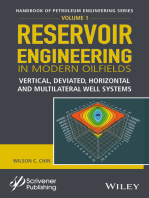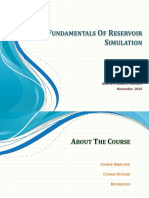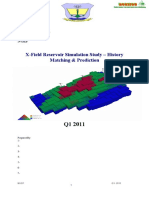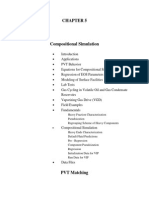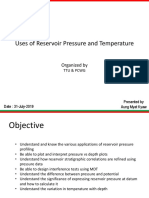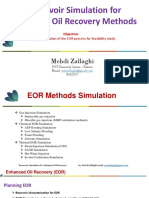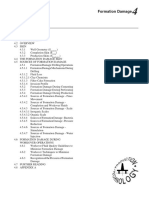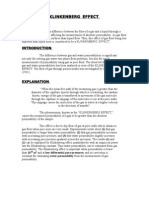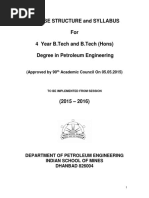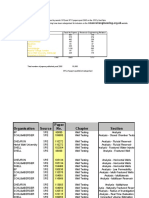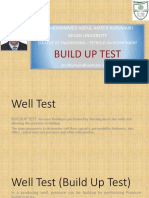Dynamic Material Balance
Dynamic Material Balance
Uploaded by
Sajid Amin ShahCopyright:
Available Formats
Dynamic Material Balance
Dynamic Material Balance
Uploaded by
Sajid Amin ShahOriginal Description:
Copyright
Available Formats
Share this document
Did you find this document useful?
Is this content inappropriate?
Copyright:
Available Formats
Dynamic Material Balance
Dynamic Material Balance
Uploaded by
Sajid Amin ShahCopyright:
Available Formats
November 2006, Volume 45, No.
11 7
Dynamic Material BalanceOil-
or Gas-in-Place Without Shut-Ins
L. MATTAR, D. ANDERSON, G. STOTTS
Fekete Associates Inc.
THIS PAPER IS BEING PUBLISHED AS A TECHNICAL NOTE AND HAS NOT BEEN PEER REVIEWED.
Abstract
Material balance calculations for determining oil- or gas-in-
place require static reservoir pressures, which can only be ob-
tained when the well is shut in. In a previous publication
(1)
titled
The Flowing Gas Material Balance, it was shown that the res-
ervoir pressure could be obtained from the flowing pressure for
wells producing at a constant rate.
The Dynamic Material Balance is an extension of the
Flowing Material Balance and can be applied to either constant
or variable flow rates. Both methods are applicable for gas and
oil. The Dynamic Material Balance is a procedure that converts
the flowing pressure at any point in time to the average reservoir
pressure that exists in the reservoir at that time. Once that is done,
the classical material balance calculations become applicable,
and a conventional material balance plot can be generated.
The procedure is graphical and very straightforward: a)
knowing the flow rate and flowing sandface pressure at any given
point in time, convert the measured flowing pressure to the av-
erage pressure that exists in the reservoir at that time; and, b) use
this calculated average reservoir pressure and the corresponding
cumulative production, to calculate the original oil- or gas-in-
place by traditional methods. The method is illustrated using data
sets.
Introduction
The material balance method is a fundamental calculation in
reservoir engineering, and is considered to yield one of the more
reliable estimates of hydrocarbons in place. In principle, it consists
of producing a certain amount of fluids, measuring the average
reservoir pressure before and after the production, and with knowl-
edge of the PVT properties of the system, calculating a mass bal-
ance as follows:
Remaining hydrocarbons-in-place = initial hydrocarbons-in-
place produced hydrocarbons
At face value, the above equation is simple; however in prac-
tice, its implementation can be quite complex, as one must account
for such variables as external fluid influx (water drive), com-
pressibility of all the fluids and of the rock, hydrocarbon phase
changes, etc.
In order to determine the average reservoir pressure, the well is
shut in, resulting in loss of production. In high permeability reser-
voirs, this may not be a significant issue, but in medium to low per-
meability reservoirs, the shut-in duration may have to last several
weeks (and sometimes months) before a reliable reservoir pressure
can be estimated. This loss of production opportunity, as well as
the cost of monitoring the shut-in pressure, is often unacceptable.
It is clear that the production rate of a well is a function of many
factors such as permeability, viscosity, thickness, etc. Also, the
rate is directly related to the driving force in the reservoir, i.e.,
the difference between the average reservoir pressure and the
TECHNICAL NOTE
TECHNICAL NOTE
THIS IS THE PERFORATION
YOU PURCHASED
*
*Based on charge performance test in API concrete target.
8 Journal of Canadian Petroleum Technology
sandface flowing pressure. Therefore, it is reasonable to expect that
knowledge about the reservoir pressure can be extracted from the
sandface flowing pressure if both the flow rate and flowing pres-
sure are measured. If, indeed, the average reservoir pressure can
be obtained from flowing conditions, then material balance calcu-
lations can be performed without having to shut in the well. This
is of great practical value. In a previous publication
(1)
, the authors
obtained a relationship between the well flowing pressure (which
can be measured) and the average reservoir pressure. They called
that procedure The Flowing Material Balance. In this Technical
Note, that procedure is extended to situations where the flow rate is
not constant. It is called the variable rate flowing material balance
or Dynamic Material Balance.
Details of the flowing material balance and the dynamic ma-
terial balance can be found in References 1 and 2. The equations
are derived for a volumetric reservoir (i.e., no water drive or ex-
ternal fluid influx), but the method can be extended to include such
complexities. The method is valid for both oil and gas systems, but
it is sometimes more convenient to present a particular concept (or
equation) in terms of gas rather than oil, or vice versa.
Dynamic Material Balance (Variable Rate
Flowing P/Z Plot)
The flowing material balance is restricted to constant rate pro-
duction. As a well produces at a constant rate in pseudo-steady
state flow, there is a consistent difference between the sandface
flowing pressure and the average reservoir pressure. This rela-
tionship can be used to acquire the average reservoir pressure and
construct the material balance plot
(1)
. However, many wells incur
significant variations in rate and flowing pressure over their pro-
duction life. The dynamic material balance
(2)
is applicable to both
constant rate and variable rate production. The complete develop-
ment of the appropriate equations can be found in References 2 and
3. A simplified summary of the concepts as they apply to variable
rate production is presented below:
Pseudo-steady state flow:
p p
qt
c N
b q
i wf
o
pss
+
........................................................................... (1)
Cumulative production:
q t N
p
( )
........................................................................................... (2)
Material balance equation:
p p
N
c N
i R
p
o
....................................................................................... (3)
Combining Equations (1), (2), and (3):
p p b q
R wf pss
.................................................................................... (4)
Re-arranging:
p p b q
R wf pss
+
.................................................................................... (5)
The above equation illustrates how the dynamic material bal-
ance can be applied to a well with a varying production rate and
a corresponding varying flowing pressure. The conversion from
flowing pressure to average reservoir pressure must take into ac-
count the varying flow rate. Since the flow rate is known, we need
only determine the value of b
pss
, using some independent method.
A plot of (p
i
p
wf
/q) vs. N
p
/q should yield a straight line when
boundary dominated flow is reached, as shown in Figure 1. The
intercept of this plot is b
pss
. Note that the value of b
pss
is subject to
interpretation, as it depends on the proper identification of the sta-
bilized (straight-line) section of the graph.
The above summary equations apply to a single phase liquid
system. Appendix C of CIPC 2005-113
(2)
presents the corre-
sponding equations for a gas reservoir. For a gas reservoir, two
modifications are necessary:
a) The pressure must be converted to pseudo-pressure to ac-
count for the dependence of viscosity and Z-factor on pres-
sure
(4)
; and,
b) Material balance time
(5-7)
must be converted to pseudo-time
to account for the strong dependence of gas compressibility
on pressure.
The step-by-step procedure for generating a dynamic material
balance plot for a gas well with varying flow rate is given below:
1. Convert initial pressure to pseudo-pressure, p
pi
;
2. Convert all flowing pressures to pseudo-pressures, p
pwf
;
3. Assume a value for the original gas-in-place, G;
4. Calculate pseudo-time from Equation (C-11)
(2)
, t
ca
;
5. Plot (p
pi
-p
pwf
/q) vs.
pseudo-time, t
ca
. The intercept gives b
pss
.
See Figure 1;
6. Calculate the average reservoir pseudo-pressure from Equa-
tion (C-19)
(2)
;
7. Convert the average reservoir pseudo-pressure to average
reservoir pressure, p
R
;
8. Calculate p
R
/Z and plot against cumulative gas produced,
Gp, just like the conventional material balance graph for a
gas pool. The intercept on the X-axis gives the original gas-
in-place, G. See Figure 2; and,
9. Using this new value of G, repeat Steps 3 to 7 until G
converges.
0.00
5.00
10.00
15.00
20.00
25.00
30.00
35.00
40.00
45.00
50.00
0.0 500.0 1,000.0 1,500.0 2,000.0 2,500.0
Np/q
b
pss
(
P
i
P
w
f
)
/
q
b
pss
FIGURE 1: Determination of b
pss
.
0
200
400
600
1,000
1,200
1,400
1,600
1,800
0 1 2 3 4 5 6 7 8 9 10
Cumulative Production (Bcf)
0
5
10
15
20
25
30
R
a
t
e
(
M
M
c
f
d
)
P/Z
800
P
r
e
s
s
u
r
e
(
p
s
i
)
Average Reservoir
Pressure
Flowing Sandface
Pressure
P/Z extrapolated to
G = 24Bcf
P/Z
Rate (MMcfd)
FIGURE 2: Dynamic material balance plot.
November 2006, Volume 45, No. 11 9
Limitations
The procedure described in this paper is very effective and pro-
vides extremely valuable information. However, like any other res-
ervoir engineering, it has its limitations:
Since material balance time and pseudo-time are rigorous
only during boundary-dominated flow, data obtained during
transient flow cannot be used in this analysis. The transient
data can be identified as the curved part of the graph in Fig-
ures 1 and 2, and should be ignored;
In certain situations such as pressure-dependent permea-
bility, or continuously changing skin (both factors have been
ignored in the development of the equations), this method
will tend to under-predict the hydrocarbons-in-place. These
factors can be accounted for by more complex definitions of
pseudo-pressure and pseudo-time; and,
The dynamic material balance is an indirect method of de-
termining the average reservoir pressure. As such, it incor-
porates many assumptions. On the other hand, build-up tests
themselves have their own sets of assumptions when the
build-up pressure has to be extrapolated to obtain the average
reservoir pressure. Accordingly, whenever possible, these
methods should be used in concert with each other rather than
as alternatives to each other.
Conclusion
It is possible to obtain the average reservoir pressure without
shutting in a well.
The flowing pressure can be converted to the average reser-
voir pressure existing at the time of the measurement using a
very direct procedure.
The average reservoir pressure obtained from the dynamic
material balance method can be used anywhere the average
reservoir pressure has traditionally been used.
For a gas well, a conventional p
R
/Z plot can easily be gen-
erated without shutting in the well, and the original gas-in-
place determined as usual.
The dynamic material balance applies to variable rate
production.
The dynamic material balance should not be viewed as a re-
placement to build-up tests, but as a very inexpensive supple-
ment to them.
NOMENCLATURE
c
o
= oil compressibility
b
B
kh
r
r
pss
e
wa
.
ln
j
(
,
\
,
(
,
,
]
]
141 2 3
4
]]
(field units)
b
B
kh
r
r
pss
e
wa
.
ln
j
(
,
\
,
(
,
,
]
]
11 57 3
4
]]
(metric units)
G = original gas-in-place
G
p
= cumulative gas produced
h = pay thickness
k = reservoir permeability
N = original oil-in-place
N
p
= cumulative production produced
p
i
= initial reservoir pressure
P
R
= average reservoir pressure
p
wf
= flowing pressure
p
p
= pseudo-pressure
p
pi
= pseudo-pressure at initial reservoir pressure
p
pwf
= pseudo-pressure at the flowing pressure
q = production rate (can be a function of time)
r
e
=
exterior radius
r
wa
=
apparent wellbore radius
t = time
t
ca
= material balance pseudo-time for gas =
dt
cg
T = reservoir temperature, R
Z
= compressibility factor at average reservoir pressure
= oil formation volume factor
= viscosity
SI Conversion Factors
1 psia = 6.895 kPa
1 MMscfd = 28.32 10
3
m
3
/d
1 bcf = 28.32 10
6
m
3
REFERENCES
1. MATTAR, L. and MCNEIL, R., The Flowing Gas Material Bal-
ance; Journal of Canadian Petroleum Technology, Vol. 37, No. 2,
pp. 52-55, February 1998.
2. MATTAR, L. and ANDERSON, D., Dynamic Material Balance;
paper CIPC 2005-113, presented at Canadian International Petro-
leum Conference, Calgary, Alberta, June 7 9, 2005.
3. BLASINGAME, T.A. and LEE, W.J ., Variable-Rate Reservoir Limits
Testing; paper SPE 15028, presented at the Permian Basin Oil and
Gas Recovery Conference, Midland, TX, March 13 15, 1986.
THIS IS THE PERFORATION
THEY DELIVERED
*
*Based on charge performance test in targeted formation sample.
10 Journal of Canadian Petroleum Technology
Authors Biographies
Louis Mattar is the president of Fekete As-
sociates Inc. He was the principal author of
the world-renowned E.R.C.B. publication,
Theory & Practice of the Testing of Gas
Wells, 1975. He specializes in well testing
and teaches it all around the world. He has
authored 45 technical publications. He is a
distinguished member of the Petroleum So-
ciety. In 1995, he received the Petroleum
Society Distinguished Author Award, and
the Outstanding Service Award. In 2003,
Louis was the SPE distinguished lecturer in
well testing.
David Anderson (P.Eng) is a technical ad-
visor with Fekete Associates Inc. He has
eight years of experience in the petroleum
industry, including production optimiza-
tion, gas deliverability modelling, and well
test analysis. He is currently the technical
leader for Feketes RTA (Rate Transient
Analysis) Group. He has taught numerous
industry courses on advanced production
decline analysis and has co-authored sev-
eral technical publications on both pressure
and rate transient analysis.
Garth Stotts (E.I.T.) is a project engineer at
Fekete Associates Inc. He acquired a B.Sc.
(with Distinction) in materials engineering
from the University of Alberta, and is cur-
rently working toward a M.Eng. at the Uni-
versity of Calgary.
4. Energy and Resource Conservation Board, E.R.C.B. Gas Well
TestingTheory and Practice; Third Edition, Alberta, Canada,
1975.
5. AGARWAL, R.G., GARDNER, D.C., KLEINSTEIBER, S.W., and
FUSSELL, D.D., Analyzing Well Production Data Using Combined
Type-Curve and Decline-Curve Analysis Concepts; SPE Reservoir
Evaluation & Engineering, pp. 478-486, October 1999.
6. FRAIM, M.L. and WATTENBARGER, R.A., Gas Reservoir Decline-
Curve Analysis Using Type Curves With Real Gas Pseudo-pressure
and Normalized Time; SPE Formation Evaluation, pp. 671-682,
December 1987.
7. PALACIO, J .C. and BLASINGAME, T.A., Decline Curve Anal-
ysis Using Type Curves: Analysis of Gas Well Production Data;
paper SPE 25909, presented at the Joint Rocky Mountain Re-
gional/Low Permeability Reservoirs Symposium, Denver, CO,
April 12 14, 1993.
ProvenanceOriginal Petroleum Society manuscript, Dynamic Material
BalanceOil- or Gas-in-Place Without Shut-Ins (2005-113TN), first
presented at the 6
th
Canadian International Petroleum Conference (the 56
th
Annual Technical Meeting of the Petroleum Society), J une 7 - 9, 2005, in
Calgary, Alberta. Abstract submitted for review December 10, 2004; edito-
rial comments sent to the author(s) October 26, 2005; revised manuscript
received December 5, 2005; paper approved for pre-press December 5,
2005; final approval October 11, 2006.
CALL FOR PAPERS
The Petroleum Society invites you to submit abstracts for
consideration to the Technical Program Committee for its
2007 Canadian International Petroleum Conference,
the Petroleum Societys 58
th
Annual Technical Meeting,
to be held at the TELUS Convention Centre, Calgary,
Alberta, Canada.
Deadline for abstracts is December 1, 2006.
We look forward to your participation!
For further information, contact the following
members of the organizing committee:
Catherine Laureshen
Conference Chairman
Alberta Energy Research Inst.
Phone: (403) 297-3638
Fax: (403) 297-3638
E-mail:
catherine.laureshen@gov.ab.ca
Dave Cuthiell
Conference Co-Chairman
Suncor Energy Inc.
Phone: (403) 205-6876
Fax: (403) 269-8738
E-mail:
dcuthiell@suncor.com
Laura Sullivan
Technical Program Chairman
Enerplus Resources Fund
Phone: (403) 298-2878
Fax: (403) 298-8882
E-mail:
lsullivan@enerplus.com
Tareq Chowdhury
Technical Prog. Co-Chairman
Rockyview Energy Inc.
Phone: (403) 538-5047
Fax: (403) 538-5050
E-mail:
chowdhuryt@rockyviewenergy.com
CANADIAN INTERNATIONAL
P E T R O L E U M C O N F E R E N C E
You might also like
- PETE 596 - Tutorial 1 in STARS BUILDERDocument25 pagesPETE 596 - Tutorial 1 in STARS BUILDERAkib ImtihanNo ratings yet
- EnQuest - Managing Uncertainty in A Mature North Sea Field Through Ensemble ModellingDocument13 pagesEnQuest - Managing Uncertainty in A Mature North Sea Field Through Ensemble ModellingMoeNo ratings yet
- History Matching Practices in Oil and GasDocument26 pagesHistory Matching Practices in Oil and GasAchmad Rafiq Alfaruqi100% (1)
- Analytical Reservoir Model in Petrel: Schlumberger-PrivateDocument8 pagesAnalytical Reservoir Model in Petrel: Schlumberger-Privatekrackku kNo ratings yet
- KAPPA Rubis TutorialDocument22 pagesKAPPA Rubis TutorialSARTHAK BAPAT100% (1)
- Spe 99668 MSDocument14 pagesSpe 99668 MSCamilo Andrés GuerreroNo ratings yet
- Reservoir Engineering in Modern Oilfields: Vertical, Deviated, Horizontal and Multilateral Well SystemsFrom EverandReservoir Engineering in Modern Oilfields: Vertical, Deviated, Horizontal and Multilateral Well SystemsNo ratings yet
- Reservoir Management2Document19 pagesReservoir Management2Ashraf Basbar100% (1)
- History Matching Exercise: 3 Cases Comparison of Reservoir Relative PermeabilitiesDocument8 pagesHistory Matching Exercise: 3 Cases Comparison of Reservoir Relative PermeabilitiesPrima Adhi SuryaNo ratings yet
- Reservoir Simulation FSDocument225 pagesReservoir Simulation FSEl Moustapha Ould CheikhNo ratings yet
- Relative Permeability Up-Scaling Examples Using Eclipse SoftwareDocument7 pagesRelative Permeability Up-Scaling Examples Using Eclipse SoftwarecarlosNo ratings yet
- Reservoir Simulation (April 2017) PDFDocument167 pagesReservoir Simulation (April 2017) PDFHuỳnh Nguyễn Hiếu Nghĩa100% (1)
- Gas Condensate PVTDocument28 pagesGas Condensate PVTapi-3718100No ratings yet
- Gas Condensate ReservoirsDocument11 pagesGas Condensate ReservoirsMaisam AbbasNo ratings yet
- History MatchDocument78 pagesHistory MatchDucke Cristie Elias Latumeten50% (2)
- TM4112 - 10 Building The Dynamic Model - SCALDocument91 pagesTM4112 - 10 Building The Dynamic Model - SCALRay Yuda100% (1)
- 03 Neural Network Proxy Modeling of Complex Oil FedutenkoDocument38 pages03 Neural Network Proxy Modeling of Complex Oil Fedutenkobillal_m_aslamNo ratings yet
- Hand-Out Note On Buckley-Leverett AnalysisDocument9 pagesHand-Out Note On Buckley-Leverett Analysismexx4u2nvNo ratings yet
- Reservoir ModelingDocument42 pagesReservoir ModelingYerasylNo ratings yet
- 8 Dynamic Uncertainty AnalysisDocument9 pages8 Dynamic Uncertainty Analysismangkoti100% (1)
- ECLIPSE SimulationDocument34 pagesECLIPSE SimulationKaoru AmaneNo ratings yet
- Setting Up A Reservoir Simulation ModelDocument30 pagesSetting Up A Reservoir Simulation ModelMariam Tatty LeonNo ratings yet
- Compositional SimulationDocument67 pagesCompositional SimulationDin Winchester100% (1)
- History Matching and Rock Mechanics 20 YearsDocument28 pagesHistory Matching and Rock Mechanics 20 YearsJamesNo ratings yet
- Development of A Modified Capillary Pressure JDocument22 pagesDevelopment of A Modified Capillary Pressure JShaho Abdulqader MohamedaliNo ratings yet
- Reservoir Simulation TPADocument56 pagesReservoir Simulation TPAYash GurjarNo ratings yet
- Eclipse Tutorial4Document11 pagesEclipse Tutorial4Cara BakerNo ratings yet
- Update Petrel ModelDocument9 pagesUpdate Petrel ModelMuhamad Afiq RosnanNo ratings yet
- Waterflood Optimization Using StreamlineDocument155 pagesWaterflood Optimization Using Streamlinechiraz100% (1)
- SW J FunctionDocument11 pagesSW J FunctionAprilya Ramadanti100% (1)
- Reservoir Simulation Report UKCSDocument190 pagesReservoir Simulation Report UKCSValar MorghulisNo ratings yet
- Coats Elements of Reservoir SimulationDocument199 pagesCoats Elements of Reservoir SimulationWelsinsin Kevin SinNo ratings yet
- Webinar Gas Condensate PVT: What's Really Important and Why?Document41 pagesWebinar Gas Condensate PVT: What's Really Important and Why?PedroNo ratings yet
- Presentation 2Document25 pagesPresentation 2Michalopoulos AlexandrosNo ratings yet
- REN5415 - Y19 - Lec13, 14 &15Document87 pagesREN5415 - Y19 - Lec13, 14 &15Abdulla MohammadNo ratings yet
- X-Field Reservoir Simulation Study - History Matching & PredictionDocument34 pagesX-Field Reservoir Simulation Study - History Matching & PredictionMahmoud Elaraby100% (1)
- TM4112 - 9 Building The Dynamic Model - PVTDocument48 pagesTM4112 - 9 Building The Dynamic Model - PVTRay YudaNo ratings yet
- Errors in History MatchingDocument10 pagesErrors in History MatchingUkpabio EyoNo ratings yet
- Scal UgDocument240 pagesScal UgKuanysh ZhassymbekNo ratings yet
- Summary & Schedule SectionDocument33 pagesSummary & Schedule SectionAkmuhammet MammetjanovNo ratings yet
- Using J Function To Match The Static Model Water Saturation - 7076291 - 01Document16 pagesUsing J Function To Match The Static Model Water Saturation - 7076291 - 01AiwarikiaarNo ratings yet
- EclipseDocument134 pagesEclipseQuynhAnh NguyenNo ratings yet
- How Lorenz Plots Are Made in Petrel RevisedDocument13 pagesHow Lorenz Plots Are Made in Petrel RevisedDeepblue09No ratings yet
- XTraining WTI HalfDay ZK PDFDocument63 pagesXTraining WTI HalfDay ZK PDFFernando OlaveoNo ratings yet
- Build A Mode Lfrom Scratch in Petrel - 1Document15 pagesBuild A Mode Lfrom Scratch in Petrel - 12009sugaNo ratings yet
- ResSimCh7 PDFDocument48 pagesResSimCh7 PDFoilkgas31No ratings yet
- Petrel RE: How To Define An Aquifer With Properties Variable With The Depth?Document7 pagesPetrel RE: How To Define An Aquifer With Properties Variable With The Depth?mcemceNo ratings yet
- Compositional SimulationDocument61 pagesCompositional SimulationCorey McKeonNo ratings yet
- Uses of Reservoir Pressure and Temperature (TTU Lecture)Document43 pagesUses of Reservoir Pressure and Temperature (TTU Lecture)AgMyat KyawNo ratings yet
- What S New in Petrel RE 2021 1638625089Document32 pagesWhat S New in Petrel RE 2021 1638625089alialamani.azlanNo ratings yet
- Eclipse 100Document43 pagesEclipse 100Tubagus FadillahNo ratings yet
- EOR Sim - MZA4Document16 pagesEOR Sim - MZA4Tpegteam TrainingNo ratings yet
- Chapter 04 - Well Path DesignDocument17 pagesChapter 04 - Well Path DesignyosephraNo ratings yet
- Basic Parameters in Reservoir Simulation For Good Performance MatchingDocument18 pagesBasic Parameters in Reservoir Simulation For Good Performance MatchingkrishNo ratings yet
- Gas Reservoir EngineeringDocument41 pagesGas Reservoir Engineeringxion_mew2100% (2)
- FundamentalsDocument39 pagesFundamentalsMoses KibikyaboNo ratings yet
- Formation Testing: Pressure Transient and Contamination AnalysisFrom EverandFormation Testing: Pressure Transient and Contamination AnalysisNo ratings yet
- Advanced Petroleum Reservoir Simulation: Towards Developing Reservoir EmulatorsFrom EverandAdvanced Petroleum Reservoir Simulation: Towards Developing Reservoir EmulatorsNo ratings yet
- Quantifying Uncertainty in Subsurface SystemsFrom EverandQuantifying Uncertainty in Subsurface SystemsCéline ScheidtNo ratings yet
- Geology of Carbonate Reservoirs: The Identification, Description and Characterization of Hydrocarbon Reservoirs in Carbonate RocksFrom EverandGeology of Carbonate Reservoirs: The Identification, Description and Characterization of Hydrocarbon Reservoirs in Carbonate RocksNo ratings yet
- Reservoir Engineering of Conventional and Unconventional Petroleum ResourcesFrom EverandReservoir Engineering of Conventional and Unconventional Petroleum ResourcesNo ratings yet
- Carr Kobayashi Burrows GasviscosityDocument2 pagesCarr Kobayashi Burrows GasviscositySajid Amin ShahNo ratings yet
- Carr Kobayashi Burrows GasviscosityDocument2 pagesCarr Kobayashi Burrows GasviscositySajid Amin ShahNo ratings yet
- Itrain BrochureDocument1 pageItrain BrochureSajid Amin ShahNo ratings yet
- Lecture Strike and DipDocument17 pagesLecture Strike and DipZAKHANNo ratings yet
- Mineral Potentials of Balochistan: Dilband - Iron Ore DepositDocument4 pagesMineral Potentials of Balochistan: Dilband - Iron Ore DepositSajid Amin ShahNo ratings yet
- My Website: Well Testing & Well Test AnalysisDocument23 pagesMy Website: Well Testing & Well Test AnalysisGadhoumiWalid100% (1)
- Drilling The Pay, Selecting TheInterval and The Initial DesignDocument13 pagesDrilling The Pay, Selecting TheInterval and The Initial DesignSuta VijayaNo ratings yet
- FALLING HeadDocument9 pagesFALLING Headjayantgupta28110No ratings yet
- Preventing Differential Sticking and Mud Losses in Highly Depleted SandsDocument10 pagesPreventing Differential Sticking and Mud Losses in Highly Depleted SandsAry RachmanNo ratings yet
- Lecture 3Document27 pagesLecture 3Homam MohammadNo ratings yet
- Reservoir Characterization - F&aDocument580 pagesReservoir Characterization - F&aОлег КупчинськийNo ratings yet
- PENG 6012 Technical Report Amanda Hendy, Jamie Ramkissoon and Rakesh SinghDocument33 pagesPENG 6012 Technical Report Amanda Hendy, Jamie Ramkissoon and Rakesh Singhshen shenNo ratings yet
- New Approach To Proportion Pervious ConcreteDocument11 pagesNew Approach To Proportion Pervious Concreteqwefqwefqwe fqwefqwNo ratings yet
- Petroleum TrapsDocument2 pagesPetroleum TrapsHazraien Abdullah HashimNo ratings yet
- Formation Damage: Geometry Comp ProductionDocument46 pagesFormation Damage: Geometry Comp ProductionkarunakarandctNo ratings yet
- Klinkenberg EffectDocument4 pagesKlinkenberg EffectQaiser Hafeez89% (9)
- IIT (ISM) SyllabusDocument34 pagesIIT (ISM) SyllabusSaurav SenguptaNo ratings yet
- Flow of Particulate-Fluid Suspension in A Channel With Porous WallsDocument27 pagesFlow of Particulate-Fluid Suspension in A Channel With Porous WallsRoberticoZeaNo ratings yet
- ReviewerDocument7 pagesReviewerRamces SolimanNo ratings yet
- The Cretaceous Limestone Producing Areas of The Mara and Maracaibo Districts, Venezuela Reservoir A N D Production EngineeringDocument18 pagesThe Cretaceous Limestone Producing Areas of The Mara and Maracaibo Districts, Venezuela Reservoir A N D Production EngineeringGilbert OmittaNo ratings yet
- StilesDocument29 pagesStilesRehman Hasan TyebNo ratings yet
- Spe Papers - Well TestingDocument71 pagesSpe Papers - Well TestingAndy Cole0% (1)
- Permeabilty TestDocument6 pagesPermeabilty Testmanoj kumarNo ratings yet
- 1 Stuck Pipe Hole Cleaning SectionDocument52 pages1 Stuck Pipe Hole Cleaning SectionjalalNo ratings yet
- P.T. Stanvac Indonesia P.T. Schlumberger Geophysics: NusantaraDocument16 pagesP.T. Stanvac Indonesia P.T. Schlumberger Geophysics: NusantarapahrengapiNo ratings yet
- Understanding Subsurface Reservoir Press PDFDocument13 pagesUnderstanding Subsurface Reservoir Press PDFAhmed GharbiNo ratings yet
- Empirical and Theoretical Analysis of A Modified Isochronal Test in A Caspian Gas ReservoirDocument8 pagesEmpirical and Theoretical Analysis of A Modified Isochronal Test in A Caspian Gas ReservoirMaria Angelica CulladoNo ratings yet
- Design and Installation of Chemical-Resistant Linings For Concrete StructuresDocument41 pagesDesign and Installation of Chemical-Resistant Linings For Concrete StructuresAnonymous aIuHKoKZjNo ratings yet
- K Suzanne 2003Document12 pagesK Suzanne 2003Javier Guerrero ArrietaNo ratings yet
- CCS - KopieDocument23 pagesCCS - KopieDavor ProfesorNo ratings yet
- Assignment 8Document3 pagesAssignment 8Engr MahwishNo ratings yet
- Well Test BUILD UPDocument9 pagesWell Test BUILD UPHassan JabbarNo ratings yet






